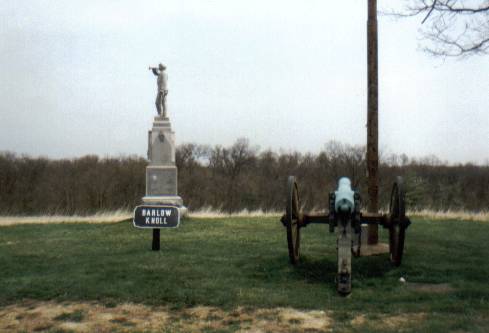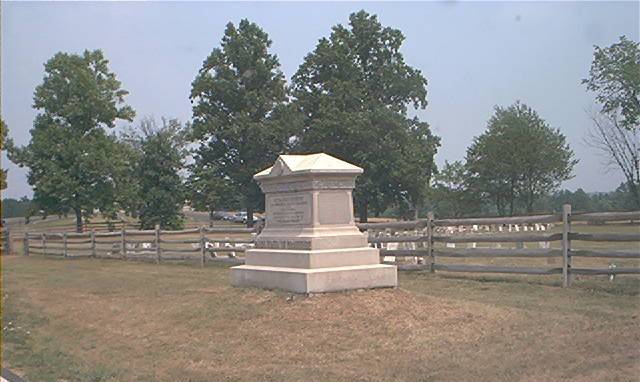|
First Shot! Visitor Center Union Army Confederate Army Copse of Trees Devil's Den Little Round Top East Calvary Field Big Round Top Spanglers Spring Triangle Field The Peach Orchard The "Bloody" Wheatfield The National Tower Culp's Hill Eternal Light Peace Memorial Reynold's Woods Benner's Hill Pickett's Charge National Cemetery and Evergreen Cemetery Battle in the Town McPherson's Ridge Railroad Cut Sach's Covered Bridge Homes on the Battlefield Barlow's Knoll Off the Beaten Path Re-enactors Credits Links Lodging Mailing List Other Battles of The Civil War  3/31/02 3/31/02
|

The silence was broken as artillery fire from Oak ridge (on the northern flank of the union line stationed on McPherson's Ridge) and Hers Ridge (the confederate position in front of McPherson's when they weren't attacking the union lines on the ridge) pounded the union lines. This was the signal that general Rodes division of Ewells confederate II corps had arived. If the union didn't do anything, the rebels could have flanked and routed them. Doubleday responded by sending his reserves under general Robinson, to oak hill. Rodes ordered an attack, but it was very unorganized and doomed to failure. Parts of Rodes division moved foward to attack. When they were in range, the union lines on oak hill poured a murderous fire on the rebel lines. Many of the men in Iverson's confederate brigade fell in this voley. The confederates moved foward and were flanked by cutler. Pined down by cutler and baxter, Iverson's brigade was taking many causalties and was forced to retreat. Back on McPherson's ridge, Pettigrew's and Brockenborough's brigades were sent foward, but couldn't break the lines. After a fierce fire fight, the outnumbered men of stone's union brigade and part of the Iron brigade pushed back the men of Pettigrews brigade. Brockenborough couldn't break the lines either, on account of their small size, and were forced to retreat. The rebel guners poured such a heavy fire on McPherson's Ridge, that no union artillery was permited to deploy along the federal lines in this position. This let the rebel guners fire on the union lines with out anything to stop or slow down their fire. The union line was reinforced by Howard's XI corps,while the confederates were reinforced by Pender's division. Howard placed one of his divisions (under general Steinwehr, made up of Coster's and Smith's brigades) on Cemetery hill as a reserve. Barlow's Division of Howard's corps was ordered foward to flank Rodes division, while to other division under general Schurz connected to I corps line to Barlow's division. They (Barlow's Division) advanced to what now is known as Barlow's knoll. This put barlow's flank in the air. General Early's confederate division of Ewells Confederate II corps arived on Barlow's flank and deployed to attack the federal position, surrounding Barlow's knoll and pushing the members of Barlows division back. Krzynowski's brigade (of Schurz division) tried to reinforce barlow's flank, but couldn't get there on time. At Oak hill, Rodes attacked and put Robinson's division under heavy presure. On McPhersons ridge, Pender's Division pushed the union line back to Seminary ridge. Barlows men routed, as did the rest of the union lines. On Seminary Ridge, the union batterys were doing their best to stop the on coming rebels, pushing back the first wave of the enemys troops but the 2nd wave of confederates stormed their lines. The union guns would have been captured, but union infantry countered and gave the batterys time to limber up and get out. The infantry on seminary ridge, like their artillery comrads were routed. Costers brigade was sent up from Cemerery hill to help Barlow, but was outflanked and forced to retreat. In the town of Gettysburg, many union troops were captured. When the union troops reached Cemetery hill, they saw General Howard and Hancock and the rout was ended. The union regiments rallyed and the first days fight was brought to a close. The union XII, II, and III corps arived. The II corps took position in the union center on Cemetery Ridge with the III corps on their left with the line ending just before reaching the round tops. The XI corps took position on Cemetery Hill. Part of the I corps took position on Stephens Knoll (named after an artillery commander that would be stationed there during the battle on the 2nd day) and part took position between the II and XI corps. The XII corps was positioned on culps hill and spanglers spring on the XI and I corps flank. the supply wagons and reserves took position (the reserve was a division from the III corps and one from the XII corps) on the baltimore pike, behind the lines on culps hill. The union lines took the shape of a fish hook. the barb being on Cemetery and Culps hill, being extended down Cemetery ridge. Ewells Corps went into position in the XII corps front. Hills corps took position on the northern part of Seminary ridge near the seminary. Longstreets corps would arrive that night. The Barlow / Gordon Incident  July 1, 1863 "In the midst of the wild disorder in his ranks, and through a storm of bullets, a Union officer was seeking to rally his men for a final stand. He, too, went down, pierced by a Miniť ball. Riding forward with my rapidly advancing lines, I discovered that brave officer lying upon his back, with the July sun pouring its rays into his pale face. He was surrounded by the Union dead, and his own life seemed to be rapidly ebbing out. Quickly dismounting and lifting his head, I gave him water from my canteen, asked his name and the character of his wounds. He was Major-General Francis C. Barlow, of New York, and of Howard's corps. The ball had entered his body in front and passed out near the spinal cord, paralyzing him in legs and arms. Neither of us had the remotest thought that he could possibly survive many hours. I summoned several soldiers who were looking after the wounded, and directed them to place him upon a litter and carry him to the shade in the rear. Before parting, he asked me to take from his pocket a package of letters and destroy them. They were from his wife. He had but one request to make of me. That request was that if I should live to the end of the war and should ever meet Mrs. Barlow, I would tell her of our meeting on the field of Gettysburg and of his thoughts of her in his last moments. He wished me to assure her that he died doing his duty at the front, that he was willing to give his life for his country, and that his deepest regret was that he must die without looking upon her face again. I learned that Mrs. Barlow was with the Union army, and near the battlefield. When it is remembered how closely Mrs. Gordon followed me, it will not be difficult to realize that my sympathies were especially stirred by the announcement that his wife was so near him. Passing through the day's battle unhurt, I dispatched at its close, under flag of truce, the promised message to Mrs. Barlow. I assured her that if she wished to come through the lines she should have safe escort to her husband's side. In the desperate encounters of the two succeeding days, and the retreat of Lee's army, I thought no more of Barlow, except to number him with the noble dead of the two armies who had so gloriously met their fate. The ball, however, had struck no vital point, and Barlow slowly recovered, though this fact was wholly unknown to me.The following summer, in battle near Richmond, my kinsman with the same initials, General J. B. Gordon of North Carolina, was killed. Barlow, who had recovered, saw the announcement of his death, and entertained no doubt that he was the Gordon whom he had met on the field of Gettysburg. To me, therefore, Barlow was dead; to Barlow, I was dead. Nearly fifteen years passed before either of us was undeceived. During my second term in the United States Senate, the Hon. Clarkson Potter, of New York, was a member of the House of Representatives. He invited me to dinner in Washington to meet a General Barlow who had served in the Union army. Potter knew nothing of the Gettysburg incident. I had heard that there was another Barlow in the Union army, and supposed, of course, that it was this Barlow with whom I was to dine. Barlow had a similar reflection as to the Gordon he was to meet. Seated at Clarkson Potter's table, I asked Barlow: "General, are you related to the Barlow who was killed at Gettysburg?" He replied: "Why, I am the man, sir. Are you related to the Gordon who killed me?" "I am the man, sir," I responded. No words of mine can convey any conception of the emotions awakened by those startling announcements. Nothing short of an actual resurrection from the dead could have amazed either of us more. Thenceforward, until his untimely death in 1896, the friendship between us which was born amidst the thunders of Gettysburg was greatly cherished by both." "Reminiscences Of The Civil War" Major-General John B. Gordon, CSA Remember to tell all your friends about our website .
"This is one of the most informational civil war sites ive ever seen!!"Julia Lee--evans,HI. "Gettysburg Battlefield Online...A Smash Hit!!"History Channel
|






